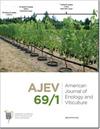Spatial Roguing Reduces the Incidence of Leafroll Disease and Curtails Its Spread in a Finger Lakes Cabernet franc Vineyard
IF 1.8
3区 农林科学
Q3 BIOTECHNOLOGY & APPLIED MICROBIOLOGY
引用次数: 1
Abstract
Leafroll is one of the most economically important viral diseases of grapevines worldwide. Grapevine leafroll-associated virus 1 (GLRaV-1) and grapevine leafroll-associated virus 3 (GLRaV-3) are prevalent in New York vineyards in which low-density grape mealybug populations reside. A five-year experiment was performed in a commercial Cabernet franc vineyard in the Finger Lakes region of New York to test the influence of spatial roguing, i.e., the elimination of virus-infected vines and their two immediate within-row neighbors on each side, on the annual incidence of GLRaV-1 and GLRaV-3. In a second treatment, spatial roguing was combined with insecticides. Vines eliminated in both spatial roguing treatments were replaced by clean vines derived from virus-tested stocks. The objective of this study was to reduce temporal virus incidence to less than 1% over two consecutive years and limit virus spread. In both spatial roguing treatments, virus incidence was reduced from 5% in 2016 to less than 1% in 2020 to 2021. Among vines in the insecticide-free, non-rogued control treatment, virus incidence increased from 5 to 16% from 2016 to 2021. Insecticides applied in 2016 to 2021 helped significantly reduce grape mealybug populations to near zero annually, while populations in the untreated control vines were 57- to 257-fold higher during the same period. However, insecticides contributed relatively little to limit the number of newly infected vines. Together, these findings highlight the salient contribution of roguing to an overall leafroll disease management response in a vineyard with low disease incidence and low grape mealybug abundance. To our knowledge, this is the first report on the effectiveness of spatial roguing at reducing the annual incidence of leafroll disease in a vineyard.芬格湖赤霞珠葡萄园的空间漫游降低了Leadoll病的发病率并遏制了其传播
葡萄疫病是世界范围内经济上最重要的葡萄病毒性疾病之一。葡萄藤卷叶相关病毒1(GLRaV-1)和葡萄藤卷叶相关病毒3(GLRaV-3)在低密度葡萄粉蚧种群所在的纽约葡萄园流行。在纽约芬格湖地区的一个商业赤霞珠法郎葡萄园进行了一项为期五年的实验,以测试空间分级对GLRaV-1和GLRaV-3年发病率的影响,即消除受病毒感染的葡萄藤及其每侧的两个相邻葡萄藤。在第二种处理中,空间roguing与杀虫剂相结合。在两种空间roguing处理中消除的葡萄藤被从经过病毒测试的库存中提取的干净葡萄藤所取代。这项研究的目的是在连续两年内将暂时性病毒发病率降至1%以下,并限制病毒传播。在这两种空间进展治疗中,病毒发病率从2016年的5%降至2020年至2021年的1%以下。从2016年到2021年,在无杀虫剂、无rogued对照处理的葡萄藤中,病毒发病率从5%增加到16%。2016年至2021年使用的杀虫剂有助于将葡萄粉蚧的数量显著减少到每年接近零的水平,而同期未经处理的对照葡萄藤的数量增加了57至257倍。然而,杀虫剂对限制新感染葡萄藤数量的作用相对较小。总之,这些发现突出了roguing对低发病率和低葡萄粉蚧丰度的葡萄园的整体卷叶病管理反应的显著贡献。据我们所知,这是第一份关于空间分级在降低葡萄园叶卷病年发病率方面的有效性的报告。
本文章由计算机程序翻译,如有差异,请以英文原文为准。
求助全文
约1分钟内获得全文
求助全文
来源期刊

American Journal of Enology and Viticulture
农林科学-生物工程与应用微生物
CiteScore
3.80
自引率
10.50%
发文量
27
审稿时长
12-24 weeks
期刊介绍:
The American Journal of Enology and Viticulture (AJEV), published quarterly, is an official journal of the American Society for Enology and Viticulture (ASEV) and is the premier journal in the English language dedicated to scientific research on winemaking and grapegrowing. AJEV publishes full-length research papers, literature reviews, research notes, and technical briefs on various aspects of enology and viticulture, including wine chemistry, sensory science, process engineering, wine quality assessments, microbiology, methods development, plant pathogenesis, diseases and pests of grape, rootstock and clonal evaluation, effect of field practices, and grape genetics and breeding. All papers are peer reviewed, and authorship of papers is not limited to members of ASEV. The science editor, along with the viticulture, enology, and associate editors, are drawn from academic and research institutions worldwide and guide the content of the Journal.
 求助内容:
求助内容: 应助结果提醒方式:
应助结果提醒方式:


